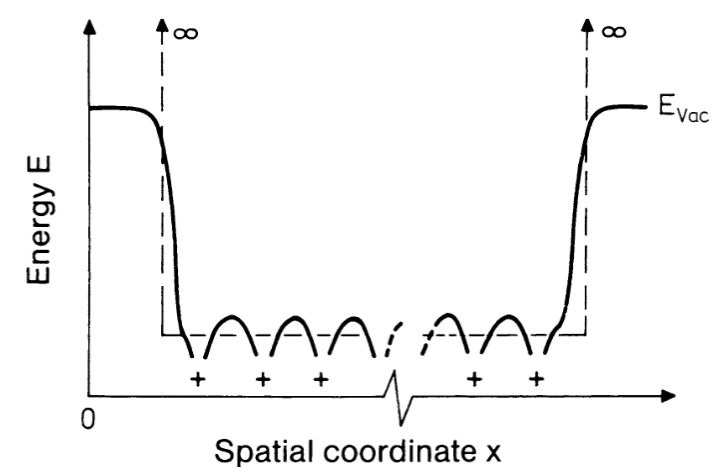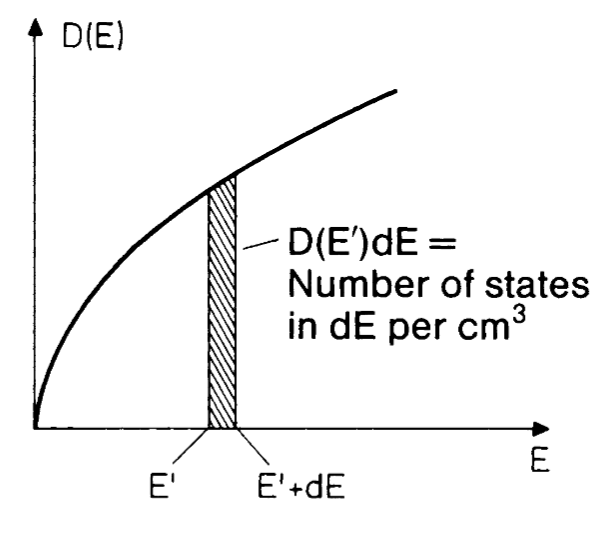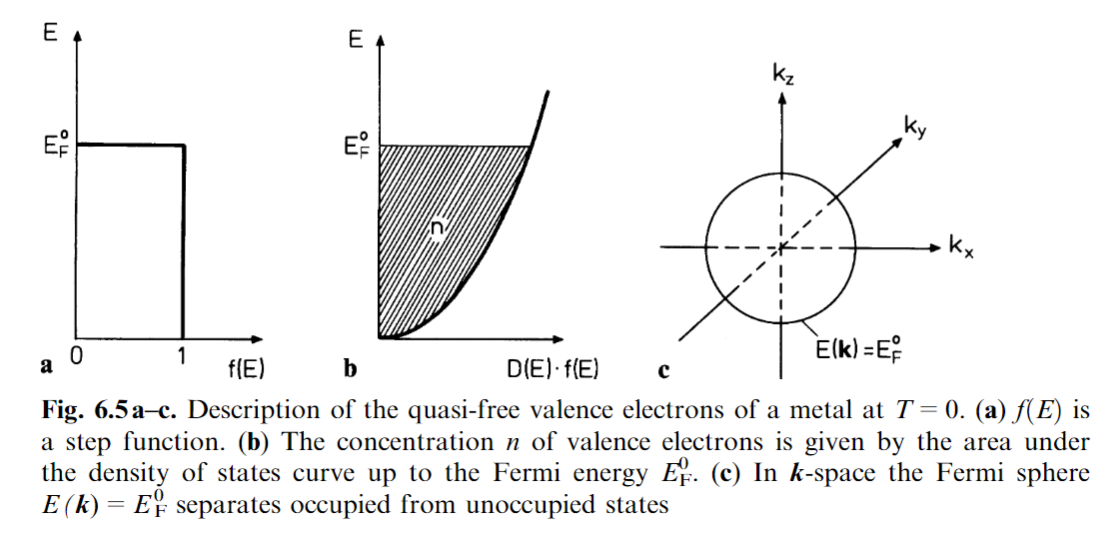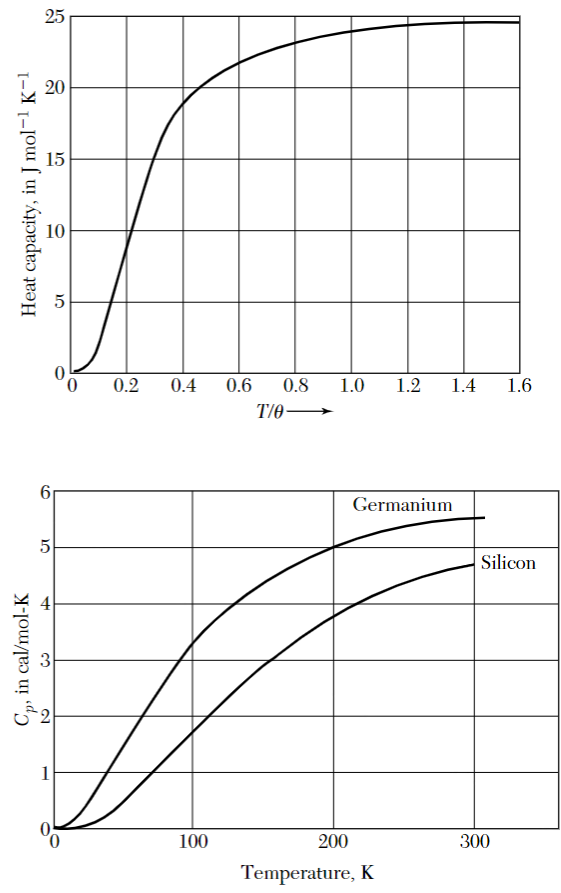Where Ibach Luth is mentioned we refer to
Ibach Luth Solid-State Physics An Introduction to Principles of Materials Science Fourth Edition
In this chapter we will deal only with the “outer” electrons, since the inner ones behave similarly to the isolated atom.
The complete SE for one electron is
where
We will always assume the following two approximations:
- Born/Oppenheimer (adiabatic) approximation: electrons and nuclei are decoupled
- Independent electrons
In the free electron model, we will also assume that the electrons are free, which means that the potential is 0 everywhere.

Sommerfeld - Bethe model
This should correspond to the free and independent electron model from condensed matter
This simpler model is useful when the electrons are loosely bound, such as in metals. The electrons are considered to be confined in box of edge
We will consider the case at
The SE will be
with
The boundary conditions are the Born - Von Karman or periodic boundary conditions:
Boundary conditions explanation omitted
By solving the SE we get that the solution is a plane wave:
The normalization constant
where
Energy eigenvalues
Boundary conditions
The BVK conditions are satisfied by imposing each of the three conditions
which means that the exponential has to be equal to
The same is true for
Notice that since
Density of states
The density of states is defined as the number of electronic states per unit energy and unit volume:
The volume of the single state (in green) is given by
If we define
Because of the spin degeneracy, each state contains two electrons, thus:
Remembering the value of the energy
Calculating the DOS from
Finally, the DOS for the free electron gas is

todo pagg 16/17 bianco ???
Energy of Fermi gas @ T = 0K
Ibach Luth, 6.2
The internal energy density
In
From this we can see that, as a consequence of the Pauli exclusion principle, even at
Since
Density of states: general formula

Fermi gas @ T > 0K
What we want to do now is estimate the width of the region where the Fermi-Dirac varies.
Ibach Luth, 6.3
If we impose
From the equation of the straight line
and, since
We finally get:
If we calculate the interceptions with the two horizontal lines
and so the range where
Which is a classical Boltzmann distribution
Thermal properties in classical gas
The internal energy of a classical gas of
and its internal energy density is
The specific heat is given by
Thermal properties in metals
Ibach Luth, 6.4
From what we just saw, we would expect that the specific heat of the electron gas would increase linearly with the number of electrons but experiments show that this is not the case. What we observe is that metals follow the Dulong-Petit law, where the specific heat tends to a constant value
The reason is simple: electrons, in contrast to a classical gas, can only gain energy if they can move into free states in their energetic neighbourhood. Looking at what we saw before, this can be expressed as the fact that the electrons that can “move” are only the ones in the region

We now want to show that the specific heat of the electrons is negligible compared to the one of the lattice.
To do this we want to calculate
Where the second integral is the density of internal energy at
From the definition of specific heat, deriving
In order to simplify the calculation we can exploit the following relation:
E_{F}\cdot n = E_{F} \int_{0}^{\infty} D(E)f(E,T) , dE \tag{6} $$
Subtracting
Focusing around
and the derivative of the Fermi function is:
substituting
c_{v}=Tk_{B}^{2}D(E_{F})\int_{-\frac{E_{F}}{k_{B}T}}^{\infty} \frac{x^{2}e^{x}}{(e^{x}+1)^{2}}, dx \tag{11}
c_{v}=Tk_{B}^{2}D(E_{F})\int_{-\infty}^{\infty} \frac{x^{2}e^{x}}{(e^{x}+1)^{2}}, dx \tag{12}
\int_{-\infty}^{\infty} \frac{x^{2}e^{x}}{(e^{x}+1)^{2}}, dx=\frac{\pi^{2}}{3} \tag{13}
c_{v}\simeq Tk_{B}^{2}D(E_{F})\frac{\pi^{2}}{3} \tag{14}
n=\int_{0}^{E_{F}}D(E) , dE \tag{15}
\displaylines{ D(E)=D(E) \frac{E_{F}^{1/2}}{E_{F}^{1/2}} =\ =\frac{m}{(\pi \hbar)^{2}} \left( \frac{2m}{\hbar^{2}} \right)^{1/2} E_{F}^{1/2} \frac{E^{1/2}}{E_{F}^{1/2}} = D(E_{F})\left( \frac{E}{E_{F}} \right)^{1/2} \tag{16} }
D(E_{F})=\frac{3}{2} \frac{n}{E_{F}} \tag{17}
c_{v}=\frac{\pi^{2}}{2}nk_{B} \frac{T}{T_{F}}
c_{v}=\gamma T+\beta T

